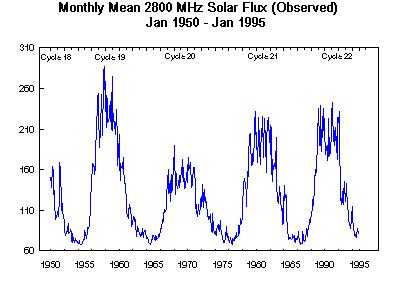Penticton/Ottawa 2800 MHz Solar Flux
The sun emits radio energy with a slowly varying intensity. This radio flux, which originates from atmospheric layers high in the sun's chromosphere and low in its corona, changes gradually from day-to-day, in response to the number of spot groups on the disk. Radio intensity levels consist of emission from three sources: from the undisturbed solar surface, from developing active regions, and from short-lived enhancements above the daily level. Solar flux density at 2800 megaHertz has been recorded routinely by radio telescopes near Ottawa (February 14, 1947-May 31, 1991) and Penticton, British Columbia, since the first of June, 1991. Each day, levels are determined at local noon (1700 GMT at Ottawa and 2000 GMT at Penticton) and then corrected to within a few percent for factors such as antenna gain, atmospheric absorption, bursts in progress, and background sky temperature. The tables published in SGD and on our FTP site contain fluxes from the entire solar disk at a frequency of 2800 megaHertz in units of 10 to the -22 Joules/second/square meter/Hertz. Each number has been multiplied by 10 to suppress the decimal point. Three sets of fluxes--the observed, the adjusted, and the absolute--are summarized. Of the three, the observed numbers are the least refined, since they contain fluctuations as large as 7% that arise from the changing sun-earth distance. In contrast, adjusted fluxes have this variation removed; the numbers in these tables equal the energy flux received by a detector located at the mean distance between sun and earth. Finally, the absolute levels carry the error reduction one step further; here each adjusted value is multiplied by 0.90 to compensate for uncertainties in antenna gain and in waves reflected from the ground.
|
